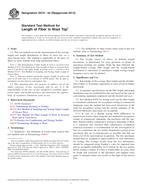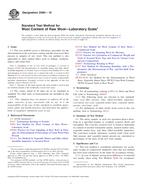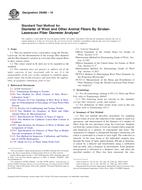We need your consent to use the individual data so that you can see information about your interests, among other things. Click "OK" to give your consent.
ASTM D4510-05(2009)
Standard Test Method for Counting Partial Cleavages in Wool and Other Animal Fibers (Withdrawn 2018)
Automatically translated name:
Standard Test Method for Counting Partial Cleavages in Wool and Other Animal Fibers
STANDARD published on 1.7.2009
The information about the standard:
Designation standards: ASTM D4510-05(2009)
Note: WITHDRAWN
Publication date standards: 1.7.2009
SKU: NS-27529
The number of pages: 8
Approximate weight : 24 g (0.05 lbs)
Country: American technical standard
Category: Technical standards ASTM
The category - similar standards:
Annotation of standard text ASTM D4510-05(2009) :
Keywords:
animal fibers, damage, partial cleavages, wool, Animal fibers, Cleavages, Damage assessment, Defects--textiles, Microprojection, Partial cleavages, Wool and wool top, ICS Number Code 59.060.10 (Natural fibres)
Additional information
| Significance and Use | ||||||||||
|
Test Method D4510 for the counting of partial cleavages, may be used for the acceptance testing of commercial shipments of wool and other animal fibers, but caution is advised, since information on between-laboratory precision is limited. Comparative tests as directed in 5.1.1 may be advisable. In case of a dispute arising from differences in reported test results when using this test method for acceptance testing of commercial shipments, the purchaser and the supplier should conduct comparative tests to determine if there is a statistical bias between their laboratories. Competent statistical assistance is recommended for the investigation of bias. As a minimum, the two parties should take a group of test specimens that are as homogeneous as possible and that are from a lot of material of the type in question. The test specimens should then be randomly assigned in equal numbers to each laboratory for testing. The average results from the two laboratories should be compared using Students t-test for unpaired data and an acceptable probability level chosen by the two parties before the testing is begun. If a bias is found, either its cause must be found and corrected or the purchaser and the supplier must agree to interpret future test results in the light of the known bias. Chemically damaged or tendered fibers are recognizable microscopically by qualified operators and should not be counted as partial cleavages. Such fibers exhibit total loss of cuticle, severe surface erosion, tenderizing cracks, longitudinal fibrillation, or a combination of these features (see Figs. 1 and 2). In a study of deliberately over-carbonized wool at one laboratory, it was found that when more than 24 tendered fibers were seen in 1 m, partial cleavage counts were significantly higher than on similar fibers that were not overcarbonized.
|
||||||||||
| 1. Scope | ||||||||||
|
1.1 This test method covers a procedure, using the microprojector, for the counting of partial cleavages in wool and other animal fibers. 1.2 The values stated in SI units are to be regarded as standard. No other units of measurement are included in this standard. 1.3 This standard does not purport to address all of the safety problems, if any, associated with its use. It is the responsibility of the user of this standard to establish appropriate safety and health practices and determine the applicability of regulatory limitations prior to use. |
||||||||||
| 2. Referenced Documents | ||||||||||
|
Similar standards:
Historical
1.7.2013
Historical
1.6.2010
Historical
1.6.2010
Historical
1.12.2012
Historical
1.7.2012
Historical
1.6.2010
We recommend:
Technical standards updating
Do you want to make sure you use only the valid technical standards?
We can offer you a solution which will provide you a monthly overview concerning the updating of standards which you use.
Would you like to know more? Look at this page.



 ASTM D519-04(2013)..
ASTM D519-04(2013).. ASTM D5238-10
ASTM D5238-10 ASTM D584-10
ASTM D584-10 ASTM D5866-12
ASTM D5866-12 ASTM D5867-12e1
ASTM D5867-12e1 ASTM D6466-10
ASTM D6466-10
 Cookies
Cookies
